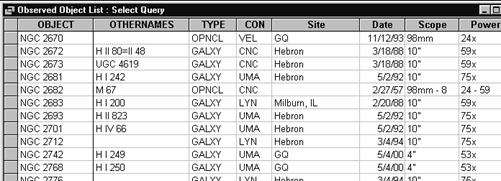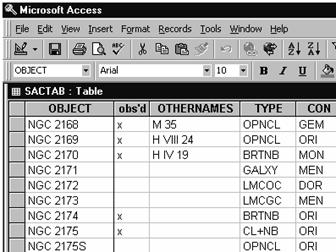Your Own Deep Sky Database
Jack Kramer
If you get glassy eyed when someone discusses the fine points of a computer program, then read no further - this will bore you. If you happen to be a little adept at exploring the intricacies of different software, and if you'd like to develop your own deep sky observing database, then read on.
In recent years there have been some fine new programs available for the observer with a PC. These are the ones that provide listings of a wide range of deep sky objects and information about each object, then let you enter your own observing notes. Typically, they're great for planning your observations. (A few are referenced at the end of this article.) But you don't have to go out and buy one of these programs, so long as you already have some sort of data storage and retrieval software, generally referred to as a database program. Microsoft Works often comes bundled on PCs for the home, and included in the Works suite is a basic database program. Even a spreadsheet program such as MS Excel or Lotus can be used to store a large amount of data on deep sky objects. Obviously, a more sophisticated database program will allow more sophisticated types of data retrieval.
About fifteen years ago, I began using dBaseIII+ for lists of deep sky objects and for my own observing records. I have since moved on to MS Access, which is an industrial-strength database program that comes with the deluxe version of the Microsoft Office suite. MS Access is also available separately.
The first issue is where do you get data on a large number of different deep sky objects. A good source is the Saguaro database, which contains detailed info on over 10,000 deep sky objects. That'll keep you busy on many, many clear nights! This database was created by members of the Saguaro Astronomy Club (SAC) in Arizona, and is widely available as freeware. You can download it from the Saguaro club web site: http://www.saguaroastro.org/content/downloads.htm. The data files are in ".asc" format - unformatted, comma-delimited ASCII text. Most database and spreadsheet programs accept this format and once all the files are imported, they can be saved as a single file in whatever format your program uses. I've imported this into dBase, MS Excel, Lotus, MS Access, and the database program in MS Works. Each deep sky object is shown with its data in several fields along a horizontal line; the data for each object is known as a "record".
The only problem I encountered was that Access converted the right ascension and declination fields to decimals. For example, the RA of NGC 2145 is 05 54.5 (5 hours, 54.5 minutes) and the Dec is -70 55 (minus 70 degrees 55 minutes). Access converted this to 5.9083 and - 70.916. A fellow with whom I corresponded on the Internet is a whiz with Access and he corrected the RA and DEC columns for me. He wrote one query to split apart the values at the decimal point. Then he converted the decimal part by multiplying by 60, after which he concatenated the two parts back together. ...Or you might prefer to just leave well enough alone!
Using MS Access, I can retrieve lists of objects that I have observed, or objects that I have not yet observed. I can also record my own comments about each object observed. In pursuit of the Herschel 400 list of objects, it's possible to pull a list of just the objects observed that are also Herschel objects. As another example of a more specialized retrieval, it would be easy to pull, let's say, a list of spiral galaxies brighter than 14th magnitude in the Virgo cluster that you have not yet observed.
The data can be retrieved on screen and printed either from the query or as nicely formatted reports. The following is a sample of the type of data included in my observed object list.
 After importing the SAC database into MS Access, I added a few fields. There's a note field for my own comments about each object, plus fields for the date and location of observation, the size of the telescope and the magnification used.
After importing the SAC database into MS Access, I added a few fields. There's a note field for my own comments about each object, plus fields for the date and location of observation, the size of the telescope and the magnification used.
In order to create unique observing lists, the most critical addition is a small field that I've labeled "obs'd". In this field, I simply enter the letter "x" in the record for each object that I've observed. To retrieve a list of objects observed, a query is created in which the search criteria for the obs'd field is "=x". To pull only those objects that haven't yet been observed, it's necessary to stipulate that there is no "x" in the obs'd field by using the criteria "Is Null". ("Null" is computerspeak for a field with no data.)
 These are the methods I've used with MS Access, but the steps won't apply if you're using different software. Nevertheless, it does demonstrate the general process for creating a database uniquely suited to your needs. At the very least, any program capable of importing and displaying data within defined fields will allow you to use the Saguaro database and add whatever additional fields you wish. The documentation file that comes with the SAC data includes info on other programs that people have used with the database.
These are the methods I've used with MS Access, but the steps won't apply if you're using different software. Nevertheless, it does demonstrate the general process for creating a database uniquely suited to your needs. At the very least, any program capable of importing and displaying data within defined fields will allow you to use the Saguaro database and add whatever additional fields you wish. The documentation file that comes with the SAC data includes info on other programs that people have used with the database.
As a side note, the Saguaro web site also includes another free database download, HNSKY, which includes 25,500 deep sky objects. I have not looked into this database; in all candor, the Saguaro database provides more objects than I can ever hope to see!
Alternative to the Do-It-Yourself Approach?
As explained above, I've opted to set up my own database simply because I already had the "raw materials", so there was no additional cost involved. But what if you don't already have any computer program that can be used for collecting and retrieving data? My suggestion would be that unless you need database software for other purposes as well, it would be far simpler to get one of the astronomy programs such as NGCView, SkyMap Pro, Sky Tools, or Deep Sky Planner. Such programs are user-friendly and will require a lot less effort on your part. Not only do they allow you to enter your own comments about deep sky objects, but some include the benefit of a sky atlas and telescope control as part of the program.
As one example of what these programs have to offer, Deep Sky Planner uses ten deep-sky and three stellar databases with a total database of over 155,500 deep-sky objects (including variable stars, double stars and quasars) combined with an extensive range of search and sort parameters. It also provides solar, lunar, and planetary ephemerides, times of astronomical darkness, and dates and times of planetary phenomena. You can open and use multiple documents and export these to formatted text or HTML. Extremely useful is the ability to cross-reference objects with chart numbers in Sky Atlas 2000, Uranometria 2000 and the Millennium Star Atlas. And you can customize it for any location.
Another program that is totally free of charge is AstroByte Logging System. It uses the Saguaro database as the source for information that is included about thousands of deep sky objects. It also provides record-keeping capability for planetary and multiple star system observations. It allows you to maintain records of objects observed versus not observed and generate reports in up to forty different formats. To get this program, go to the web site: http://mainbyte.com/astrobyte/
It's just a question of how sophisticated you want your record keeping to be and how much you're willing to spend for the software. If you have such a program, how about writing a review of it for a future issue of the newsletter?
Published in the May 2007 issue of the NightTimes




